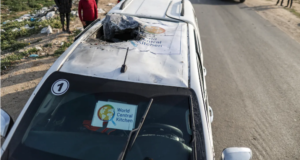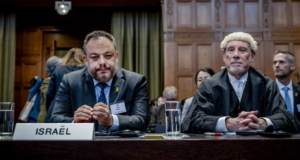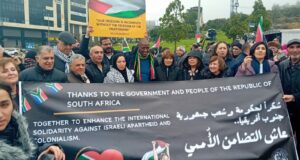International Solidarity Movement
14 May 2010

Settlers, Palestinians in the street of Sheikh Jarrah
Hundreds of settlers held disruptive celebrations in the Palestinian neighborhood of Sheikh Jarrah yesterday in honor of “Jerusalem Day”. Dancing, screaming and praying in the street, the settlers disrupted life for over six hours, as police barricades and teeming masses prevented traffic from flowing as usual. One Palestinian woman was violently assaulted in the afternoon, resulting in a gash across her face and a broken nose. Palestinian residents observing from their homes and/or sidewalk were subjected to the extremely racist harassment which is consistent with any settler activity.
Palestinians, Israelis and internationals staging a small counter-demonstration were forced by police out of the street and onto the sidewalk. This restriction on freedom of speech came shortly after massive crowds of settlers effectively closed the street for hours, filling multiple blocks with police-facilitated nationalist celebrations of ethnic cleansing. Four Israeli activists were arrested after a small counter-demonstration held at the entrance to Sheikh Jarrah.

Palestinian women protest racist "Jerusalem Day" outside of occupied Gawi house
“Jerusalem Day” according to the Hebrew calendar, falls 2-3 weeks after the end of the war of 1967 when Jerusalem was “unified”. In reality, this holiday observes the beginning of a systematic ethnic cleansing of the Palestinian would-be capital, East Jerusalem. “Jerusalem Day” is observed with a march through West Jerusalem and the Old City, particularly the Muslim Quarter. In the past few years, the march has taken a very extreme nationalist character, and extreme right messages are celebrated. Last year, there were violent clashes when marchers attacked Palestinians while marching though the Old City and attacked Israeli leftist protestors who held a quiet demonstration near the march.
Contextual background on Sheikh Jarrah
Approximately 475 Palestinian residents living in the Karm Al-Ja’ouni neighborhood of Sheikh Jarrah, located directly north of the Old City, face imminent eviction from their homes. All 28 families are refugees from 1948, primarily from West Jerusalem and Haifa, whose houses in Sheikh Jarrah were built and given to them through a joint project between the United Nations Relief and Works Agency (UNRWA) and the Jordanian government in 1956.
Facing systematic ethnic cleansing through the Israeli judicial system, all 28 families of the neighborhood ultimately await eviction. The violent eviction of theKamel al-Kurd family, by Israeli police and settlers in November of 2008, resulted in the death of ailing Abu Kamel (Mohammad) al Kurd, 61. The August 2009 evictions of the Gawi and Hannoun extended families and December 2009 occupation of Rifqa al Kurd’s front addition followed, beginning a visible trend of ethnic cleansing in Sheikh Jarrah. Over 60 residents, including 20 children, have now been displaced.
The evicted families established protest tents near their homes, many of which were repeatedly demolished by the Jerusalem Municipality. As a result, only the Rifqa al Kurd tent remains standing. Members of the Gawi, Hannoun and Kamel al Kurd families continue a daily presence outside of the occupied Gawi home. The Palestinians and their international and Israeli supporters face continual harassment from Israeli settlers. Police presence in the community is almost entirely directed at prosecuting Palestinians, and not in neutrally protecting residents from harassment and violence.
Constructing new Jewish settlements and/or occupying Palestinian homes in East Jerusalem and the West Bank is illegal under many international laws, including Article 49 of the Fourth Geneva Convention. The plight of the Gawi, al-Kurd and Hannoun families is just a small part of Israel’s ongoing campaign of the ethnic cleansing of Palestinians from East Jerusalem, the capital of a hypothetical independent state.
Legal Background
The eviction orders, issued by Israeli courts, are a result of claims made in 1967 by the Sephardic Community Committee and the Knesseth Yisrael Association (who since sold their claim to the area to Nahalat Shimon) – settler organizations whose aim is to take over the whole area using falsified deeds for the land dating back to 1875. In 1972, these two settler organizations applied to have the land registered in their names with the Israel Lands Administration (ILA). Their claim to ownership was noted in the Land Registry; however, it was never made into an official registry of title. The first Palestinian property in the area was taken over at this time.
The case continued in the courts for another 37 years. Amongst other developments, the first lawyer of the Palestinian residents reached an agreement with the settler organizations in 1982 (without the knowledge or consent of the Palestinian families) in which he recognized the settlers’ ownership in return for granting the families the legal status of protected tenants. This affected 23 families and served as a basis for future court and eviction orders (including theal -Kurd family house take-over in December 2009), despite the immediate appeal filed by the families’ new lawyer. Furthermore, a Palestinian landowner, Suleiman Darwish Hijazi , has legally challenged the settlers’ claims. In 1994 he presented documents certifying his ownership of the land to the courts, including tax receipts from 1927. In addition, the new lawyer of the Palestinian residents located a document, proving the land inSheikh Jarrah had never been under Jewish ownership. The Israeli courts rejected these documents.
The first eviction orders were issued in 1999 based on the (still disputed) agreement from 1982 and, as a result, two Palestinian families (Hannoun and Gawi) were evicted in February 2002. After the 2006 Israeli Supreme Court finding that the settler committees’ ownership of the lands was uncertain, and the Lands Settlement officer of the court requesting that the ILA remove their names from the Lands Registrar, the Palestinian families returned back to their homes. The courts, however, failed to recognize new evidence presented to them and continued to issue eviction orders based on decisions from 1982 and 1999 respectively. Further evictions followed in November 2008 (Kamel al-Kurd family) and August 2009 (Hannoun and Gawi families for the second time). An uninhabited section of a house belonging to the al-Kurd family was taken over by settlers on 1 December 2009.
The ultimate aim of the Zionist organizations is to convert Sheikh Jarrah into a new Jewish settlement and to create a Jewish continuum that will effectively cut off the Old City from the northern Palestinian neighborhoods. On 28 August 2008,Nahalat Shimon International filed a plan to build a series of five and six-story apartment blocks – Town Plan Scheme (TPS) 12705 – in the Jerusalem Local Planning Commission. If TPS 12705 comes to pass, the existing Palestinian houses in this key area would be demolished, about 500 Palestinians would be evicted, and 200 new settler units would be built for a new settlement: Shimon HaTzadik
 International Solidarity Movement Nonviolence. Justice. Freedom.
International Solidarity Movement Nonviolence. Justice. Freedom.


